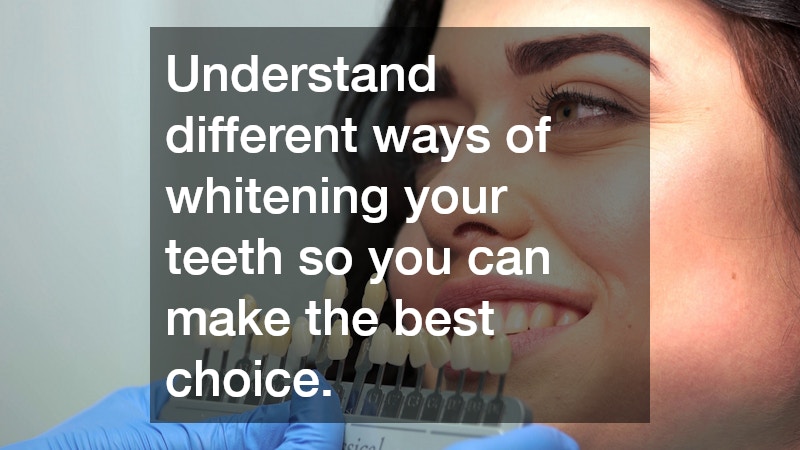
A bright, white smile can boost confidence and enhance overall appearance. Many people seek methods to remove stains and discoloration caused by food, drinks, aging, or habits such as smoking. Achieving a whiter smile can involve professional treatments, at-home solutions, or natural remedies. Understanding the effectiveness, safety, and potential risks of each method of teeth whitening is essential for achieving results while maintaining oral health.
Are At-Home Whitening Kits Effective?
At-home whitening kits are a popular choice for people seeking convenience and affordability. These kits provide various levels of bleaching or stain removal depending on the product type.
Types of At-Home Whitening Kits
Common types of at-home kits include whitening strips, trays with gel, paint-on pens, and LED light devices. Each method uses peroxide-based formulas to lighten tooth color. Strips and trays typically provide the most consistent results, while pens and paint-on gels are better for spot treatments.
Pros and Cons of At-Home Whitening Kits
The benefits of at-home kits include convenience, lower cost, and the ability to apply treatment on your own schedule. However, the results are usually slower than professional treatments, and improper use can lead to tooth sensitivity or gum irritation. Kits with lower peroxide concentration may require multiple applications for noticeable results.
Comparing Different Brands
Different brands vary in peroxide concentration, application methods, and treatment duration. Choosing a reputable brand is important to ensure safety and effectiveness. Reading reviews, consulting dental professionals, and following instructions closely can help users achieve the best outcome.
How to Use At-Home Kits Safely
To use whitening kits safely, avoid leaving products on for longer than recommended. Protect gums from contact with bleaching agents, and follow the instructions provided with the product. Rinse thoroughly after each application to remove residual gel or chemical solution.
Common Mistakes with At-Home Whitening
Common mistakes include overuse, inconsistent application, and ignoring tooth sensitivity. Excessive use can damage enamel and lead to long-term sensitivity. Skipping steps or applying unevenly can result in uneven whitening. Regular dental check-ups ensure that at-home whitening does not harm oral health.
How Do Professional Whitening Treatments Work?
Professional whitening treatments are performed under the supervision of a dentist and provide faster, more noticeable results compared to at-home options.
Overview of Professional Whitening Methods
Professional whitening methods include in-office bleaching, laser-assisted treatments, and take-home kits provided by dentists. These treatments use stronger peroxide solutions and specialized equipment for more effective whitening. In-office treatments often achieve significant results in one or two sessions.
Advantages of In-Office Treatments
The main advantages include rapid results, precision application, and reduced risk of gum irritation. Dentists can target stained areas and adjust treatment strength to minimize sensitivity. Professional supervision also ensures that any underlying dental issues are addressed before whitening.
Cost vs. Results: Is It Worth It?
Professional treatments are more expensive than at-home kits, but they generally provide longer-lasting and more uniform results. For individuals seeking significant whitening in a short time or who have deep discoloration, the investment may be worthwhile.
Pre-Treatment Considerations
Before whitening, a dentist will evaluate oral health, looking for cavities, gum disease, or enamel damage. Treatment is safer and more effective when teeth and gums are healthy. Pre-treatment cleaning is often recommended to remove plaque and tartar.
What to Expect During a Professional Session
During the session, protective barriers are placed on the gums to prevent irritation. The whitening solution is applied to the teeth, sometimes with heat or light to enhance results. The procedure usually takes one to two hours, and patients can see immediate improvement. Post-treatment care includes avoiding staining foods and maintaining good oral hygiene.
What Natural Remedies Are Available for Teeth Whitening?
Some people prefer natural methods for whitening teeth, although these are generally less effective than professional treatments.
Baking Soda and Hydrogen Peroxide
Baking soda mixed with hydrogen peroxide can act as a mild abrasive to remove surface stains. This mixture should be used sparingly to avoid enamel erosion. Brushing gently and rinsing thoroughly can help minimize risks.
Benefits of Oil Pulling
Oil pulling involves swishing coconut, sesame, or sunflower oil in the mouth for several minutes. While it may reduce bacteria and plaque, scientific evidence supporting significant whitening effects is limited. Oil pulling is considered safe when done correctly.
Using Activated Charcoal Safely
Activated charcoal has gained popularity for its stain-removing properties. However, excessive or aggressive use can wear down enamel. It is best to use charcoal products occasionally and with soft-bristled brushes.
Whitening with Fruit Peels
Some fruits, such as strawberries and lemons, contain natural acids or enzymes that can lighten surface stains. While these methods may provide mild whitening, overuse can damage enamel due to acidic content. Limiting application and rinsing afterward is recommended.
Potential Risks of Natural Remedies
Natural remedies can pose risks if used excessively or improperly. Enamel erosion, gum irritation, and increased tooth sensitivity are common side effects. Consulting a dentist before using natural methods ensures safety and prevents unintended damage.
Conclusion
Achieving a whiter smile requires balancing effectiveness, safety, and personal preference. At-home whitening kits provide convenience but require careful use to avoid sensitivity and uneven results. Professional treatments offer rapid, consistent results under expert supervision, making them ideal for deeper stains or quicker outcomes. Natural remedies may offer mild improvements, but they carry risks and are generally less effective.
Maintaining oral health is essential for all whitening methods. Regular dental check-ups, proper brushing and flossing, and avoiding stain-causing foods and beverages can enhance and prolong whitening results. By understanding the options available, their benefits, and potential risks, individuals can make informed decisions and enjoy a bright, healthy smile.

